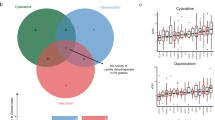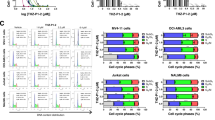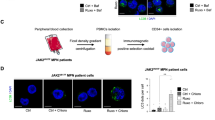Abstract
The serine/threonine kinase mammalian target of rapamycin (mTOR) is crucial for cell growth and proliferation, and is constitutively activated in primary acute myeloid leukemia (AML) cells, therefore representing a major target for drug development in this disease. We show here that the specific mTOR kinase inhibitor AZD8055 blocked mTORC1 and mTORC2 signaling in AML. Particularly, AZD8055 fully inhibited multisite eIF4E-binding protein 1 phosphorylation, subsequently blocking protein translation, which was in contrast to the effects of rapamycin. In addition, the mTORC1-dependent PI3K/Akt feedback activation was fully abrogated in AZD8055-treated AML cells. Significantly, AZD8055 decreased AML blast cell proliferation and cell cycle progression, reduced the clonogenic growth of leukemic progenitors and induced caspase-dependent apoptosis in leukemic cells but not in normal immature CD34+ cells. Interestingly, AZD8055 strongly induced autophagy, which may be either protective or cell death inducing, depending on concentration. Finally, AZD8055 markedly increased the survival of AML transplanted mice through a significant reduction of tumor growth, without apparent toxicity. Our current results strongly suggest that AZD8055 should be tested in AML patients in clinical trials.
This is a preview of subscription content, access via your institution
Access options
Subscribe to this journal
Receive 12 print issues and online access
$259.00 per year
only $21.58 per issue
Buy this article
- Purchase on Springer Link
- Instant access to full article PDF
Prices may be subject to local taxes which are calculated during checkout





Similar content being viewed by others
References
Kolch W, Pitt A . Functional proteomics to dissect tyrosine kinase signalling pathways in cancer. Nat Rev 2010; 10: 618–629.
Sujobert P, Bardet V, Cornillet-Lefebvre P, Hayflick JS, Prie N, Verdier F et al. Essential role for the p110delta isoform in phosphoinositide 3-kinase activation and cell proliferation in acute myeloid leukemia. Blood 2005; 106: 1063–1066.
Chapuis N, Tamburini J, Green AS, Willems L, Bardet V, Park S et al. Perspectives on inhibiting mTOR as a future treatment strategy for hematological malignancies. Leukemia 2010; 24: 1686–1699.
Sabatini DM . mTOR and cancer: insights into a complex relationship. Nat Rev 2006; 6: 729–734.
Guertin DA, Sabatini DM . Defining the role of mTOR in cancer. Cancer Cell 2007; 12: 9–22.
Bai X, Ma D, Liu A, Shen X, Wang QJ, Liu Y et al. Rheb activates mTOR by antagonizing its endogenous inhibitor, FKBP38. Science 2007; 318: 977–980.
Ruvinsky I, Meyuhas O . Ribosomal protein S6 phosphorylation: from protein synthesis to cell size. Trends Biochem Sci 2006; 31: 342–348.
Gingras AC, Raught B, Sonenberg N . Regulation of translation initiation by FRAP/mTOR. Genes Dev 2001; 15: 807–826.
De Benedetti A, Graff JR . eIF-4E expression and its role in malignancies and metastases. Oncogene 2004; 23: 3189–3199.
Jacinto E, Loewith R, Schmidt A, Lin S, Ruegg MA, Hall A et al. Mammalian TOR complex 2 controls the actin cytoskeleton and is rapamycin insensitive. Nat Cell Biol 2004; 6: 1122–1128.
Sarbassov DD, Ali SM, Kim DH, Guertin DA, Latek RR, Erdjument-Bromage H et al. Rictor, a novel binding partner of mTOR, defines a rapamycin-insensitive and raptor-independent pathway that regulates the cytoskeleton. Curr Biol 2004; 14: 1296–1302.
Zeng Z, Sarbassov dos D, Samudio IJ, Yee KW, Munsell MF, Ellen Jackson C et al. Rapamycin derivatives reduce mTORC2 signaling and inhibit AKT activation in AML. Blood 2007; 109: 3509–3512.
Sarbassov DD, Guertin DA, Ali SM, Sabatini DM . Phosphorylation and regulation of Akt/PKB by the rictor-mTOR complex. Science 2005; 307: 1098–1101.
Garcia-Martinez JM, Alessi DR . mTOR complex 2 (mTORC2) controls hydrophobic motif phosphorylation and activation of serum- and glucocorticoid-induced protein kinase 1 (SGK1). Biochem J 2008; 416: 375–385.
Tamburini J, Green AS, Chapuis N, Bardet V, Lacombe C, Mayeux P et al. Targeting translation in acute myeloid leukemia: a new paradigm for therapy? Cell Cycle 2009; 8: 3893–3899.
Perl AE, Kasner MT, Tsai DE, Vogl DT, Loren AW, Schuster SJ et al. A phase I study of the mammalian target of rapamycin inhibitor sirolimus and MEC chemotherapy in relapsed and refractory acute myelogenous leukemia. Clin Cancer Res 2009; 15: 6732–6739.
Tamburini J, Green AS, Bardet V, Chapuis N, Park S, Willems L et al. Protein synthesis is resistant to rapamycin and constitutes a promising therapeutic target in acute myeloid leukemia. Blood 2009; 114: 1618–1627.
Assouline S, Culjkovic B, Cocolakis E, Rousseau C, Beslu N, Amri A, Caplan S, Leber B, Roy DC, Miller Jr WH, Borden KL . Molecular targeting of the oncogene eIF4E in AML: a proof-of-principle clinical trial with ribavirin. Blood 2009; 114: 257–260.
Carroll M . Taking aim at protein translation in AML. Blood 2009; 114: 1458–1459.
Silvera D, Formenti SC, Schneider RJ . Translational control in cancer. Nat Rev 2010; 10: 254–266.
Tamburini J, Chapuis N, Bardet V, Park S, Sujobert P, Willems L et al. Mammalian target of rapamycin (mTOR) inhibition activates phosphatidylinositol 3-kinase/Akt by up-regulating insulin-like growth factor-1 receptor signaling in acute myeloid leukemia: rationale for therapeutic inhibition of both pathways. Blood 2008; 111: 379–382.
Green AS, Chapuis N, Trovati Maciel T, Willems L, Lambert M, Arnoult C et al. The LKB1/AMPK signaling pathway has tumor suppressor activity in acute myeloid leukemia through the repression of mTOR-dependent oncogenic mRNA translation. Blood 2010; 116: 4262–4273.
Tanaka T, Tsudo M, Karasuyama H, Kitamura F, Kono T, Hatakeyama M et al. A novel monoclonal antibody against murine IL-2 receptor beta-chain. Characterization of receptor expression in normal lymphoid cells and EL-4 cells. J Immunol 1991; 147: 2222–2228.
Copp J, Manning G, Hunter T . TORC-specific phosphorylation of mammalian target of rapamycin (mTOR): phospho-Ser2481 is a marker for intact mTOR signaling complex 2. Cancer Res 2009; 69: 1821–1827.
Soliman GA, Acosta-Jaquez HA, Dunlop EA, Ekim B, Maj NE, Tee AR et al. mTOR S2481 autophosphorylation monitors mTORC-specific catalytic activity and clarifies rapamycin mechanism of action. J Biol Chem 2009; 285: 7866–7879.
Garcia-Martinez JM, Moran J, Clarke RG, Gray A, Cosulich SC, Chresta CM et al. Ku-0063794 is a specific inhibitor of the mammalian target of rapamycin (mTOR). Biochem J 2009; 421: 29–42.
Rodrik-Outmezguine VS, Chandarlapaty S, Pagano NC, Poulikakos PI, Scaltriti M, Moskatel E et al. mTOR kinase inhibition causes feedback-dependent biphasic regulation of AKT signaling. Cancer Discov 2011; 2011: 248–259.
Thoreen CC, Kang SA, Chang JW, Liu Q, Zhang J, Gao Y et al. An ATP-competitive mTOR inhibitor reveals rapamycin-insensitive functions of mTORC1. J Biol Chem 2009; 284: 8023–8032.
Chapuis N, Tamburini J, Green AS, Vignon C, Bardet V, Neyret A et al. Dual inhibition of PI3K and mTORC1/2 signalling by NVP-BEZ235 as a new therapeutic strategy for acute myeloid leukemia. Clin Cancer Res 2010; 16: 5424–5435.
Puissant A, Robert G, Auberger P . Targeting autophagy to fight hematopoietic malignancies. Cell Cycle 2010; 9: 3470–3478.
Sini P, James D, Chresta C, Guichard S . Simultaneous inhibition of mTORC1 and mTORC2 by mTOR kinase inhibitor AZD8055 induces autophagy and cell death in cancer cells. Autophagy 2010; 6: 553–554.
Feldman ME, Apsel B, Uotila A, Loewith R, Knight ZA, Ruggero D et al. Active-site inhibitors of mTOR target rapamycin-resistant outputs of mTORC1 and mTORC2. PLoS Biol 2009; 7: e38.
Janes MR, Limon JJ, So L, Chen J, Lim RJ, Chavez MA et al. Effective and selective targeting of leukemia cells using a TORC1/2 kinase inhibitor. Nat Med 2010; 16: 205–213.
Park S, Chapuis N, Bardet V, Tamburini J, Gallay N, Willems L et al. PI-103, a dual inhibitor of Class IA phosphatidylinositide 3-kinase and mTOR, has antileukemic activity in AML. Leukemia 2008; 22: 1698–1706.
Yu K, Toral-Barza L, Shi C, Zhang WG, Lucas J, Shor B et al. Biochemical, cellular, and in vivo activity of novel ATP-competitive and selective inhibitors of the mammalian target of rapamycin. Cancer Res 2009; 69: 6232–6240.
Carracedo A, Ma L, Teruya-Feldstein J, Rojo F, Salmena L, Alimonti A et al. Inhibition of mTORC1 leads to MAPK pathway activation through a PI3K-dependent feedback loop in human cancer. J Clin Invest 2008; 118: 3065–3074.
Manning BD . Balancing Akt with S6K: implications for both metabolic diseases and tumorigenesis. J Cell Biol 2004; 167: 399–403.
Svejda B, Kidd M, Kazberouk A, Lawrence B, Pfragner R, Modlin IM . Limitations in small intestinal neuroendocrine tumor therapy by mTor kinase inhibition reflect growth factor-mediated PI3K feedback loop activation via ERK1/2 and AKT. Cancer 2011; 117: 4141–4154.
Chresta CM, Davies BR, Hickson I, Harding T, Cosulich S, Critchlow SE et al. AZD8055 is a potent, selective, and orally bioavailable ATP-competitive mammalian target of rapamycin kinase inhibitor with in vitro and in vivo antitumor activity. Cancer Res 2010; 70: 288–298.
Collins BJ, Deak M, Arthur JS, Armit LJ, Alessi DR . In vivo role of the PIF-binding docking site of PDK1 defined by knock-in mutation. EMBO J 2003; 22: 4202–4211.
Engelman JA, Luo J, Cantley LC . The evolution of phosphatidylinositol 3-kinases as regulators of growth and metabolism. Nat Rev Genet 2006; 7: 606–619.
Altman JK, Sassano A, Kaur S, Glaser H, Kroczynska B, Redig AJ et al. Dual mTORC2/mTORC1 targeting results in potent suppressive effects on acute myeloid leukemia (AML) progenitors. Clin Cancer Res 2011; 17: 4378–4388.
Gozuacik D, Kimchi A . Autophagy as a cell death and tumor suppressor mechanism. Oncogene 2004; 23: 2891–2906.
Bhutia SK, Kegelman TP, Das SK, Azab B, Su ZZ, Lee SG et al. Astrocyte elevated gene-1 induces protective autophagy. Proceedings of the National Academy of Sciences of the United States of America. 2010; 107: 22243–22248.
Bellodi C, Lidonnici MR, Hamilton A, Helgason GV, Soliera AR, Ronchetti M et al. Targeting autophagy potentiates tyrosine kinase inhibitor-induced cell death in Philadelphia chromosome-positive cells, including primary CML stem cells. J Clin Invest 2009; 119: 1109–1123.
Acknowledgements
We thank all participating investigators from the GOELAMS. This work was supported by grants from the Ligue Nationale Contre le Cancer (LNCC, laboratoire associé), the Fondation de France (comité leucémies), the Institut National du Cancer (INCa) and the Association Laurette Fugain. We thank Olivier Thibaudeau (Institut Claude Bernard, Faculté de Médecine Paris Diderot, France) for his assistance on histological sample processing. We thank Dr Nabih Azar, Hôpital de la Pitié-Salpétrière, Paris, France, for his contribution to normal hematopoietic cells collection. INSERM U895 / Team 2 is an Equipe Labellisée par la LNCC (2011-2013).
Author contributions
LW and NC performed the research, analyzed the data and wrote the manuscript; AP performed autophagy experiments; TTM and AF performed mice experiments; ASG performed experiments and analyzed the data; CV performed cell cycle analysis; NJ, SP, SG, OH, OH, ICM and PA analyzed clinical and biological data; NI and FD contributed AML patient samples and analyzed clinical data; CL and PM analyzed the data; DB and JT designed the research, analyzed the data and wrote the manuscript.
Author information
Authors and Affiliations
Corresponding authors
Ethics declarations
Competing interests
Sylvie Guichard is an employee of AstraZeneca Cancer & Infection Research Area, Alderley Park, United Kingdom.
Additional information
Supplementary Information accompanies the paper on the Leukemia website
Supplementary information
Rights and permissions
About this article
Cite this article
Willems, L., Chapuis, N., Puissant, A. et al. The dual mTORC1 and mTORC2 inhibitor AZD8055 has anti-tumor activity in acute myeloid leukemia. Leukemia 26, 1195–1202 (2012). https://doi.org/10.1038/leu.2011.339
Received:
Revised:
Accepted:
Published:
Issue Date:
DOI: https://doi.org/10.1038/leu.2011.339
Keywords
This article is cited by
-
Multifaceted role of mTOR (mammalian target of rapamycin) signaling pathway in human health and disease
Signal Transduction and Targeted Therapy (2023)
-
The dual role of autophagy in acute myeloid leukemia
Journal of Hematology & Oncology (2022)
-
LINC00649 underexpression is an adverse prognostic marker in acute myeloid leukemia
BMC Cancer (2020)
-
Exploiting metabolic vulnerabilities for personalized therapy in acute myeloid leukemia
BMC Biology (2019)
-
Mechanisms of autophagy and relevant small-molecule compounds for targeted cancer therapy
Cellular and Molecular Life Sciences (2018)



